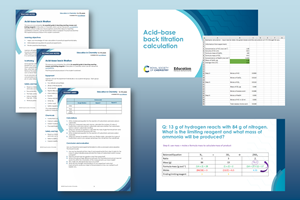Experiment and develop learners’ quantitative analysis skills
This resource accompanies the article The essential guide to teaching quantitative chemistry in Education in Chemistry, where you will find tips, common misconceptions and further ideas for teaching reacting masses and limiting reagents.
Use the technician notes to prepare the practical and find the experimental procedure in the student worksheet.
Learning objectives
- Apply your knowledge of mole calculations to practical experimental data.
- Write balanced equations for practical experiments.
- Review practical techniques.
Learners will address all three objectives throughout the experiment. They should successfully carry out the practical, write relevant balanced equations and utilise these to carry out mole calculations. Learners will draw their findings together in a conclusion and evaluation, comparing their experimental and theoretical data. Find the answers in the teacher notes and use the accompanying mole calculator spreadsheet to check learners’ calculations.
Scaffolding
Some learners will be keen to work through the whole task independently. Others will benefit from you checking the calculation steps as they go along, ensuring they have correctly balanced the equations and found the masses and moles before they write their conclusion and evaluation. Use the PowerPoint (also available as a pdf) to model each step of the calculation. Remove the example tables in the student sheet to encourage learners to draw their own or leave them in for support.
As an extension, ask learners to titrate the original HCl against the NaOH to check the concentration is correct. They can also investigate the effect of CO2 dissolving on the pH of water.
Safety and hazards
- Read our standard health and safety guidance and carry out a risk assessment before running any live practical.
- Eye protection must be worn.
- The flask containing hydrochloric acid and calcium carbonate may get warm.
- Instruct learners to take care not to spill solutions, particularly phenolphthalein, on their skin. If they do get any on their skin, rinse well.
- Fill the burette at eye level.
Equipment
Do the experiment individually or as a pair/small group. Each learner/group will require:
- Two 100 ml conical flasks
- 25 ml or 50 ml pipette
- 10 ml pipette
- Pipette fillers sized to match pipettes
- Mass balance measuring three decimal places (0.001 g)*
- Burette
- Clamp and retort
- White tile
- Cotton wool
- Safety equipment: safety glasses
*If a mass balance measuring three decimal places is not available then use a mass balance measuring two decimal places (0.01 g). This will be less accurate though.
Chemicals
- Hydrochloric acid, 1.00 mol dm-3
- Calcium carbonate chips (approx 1.00 g)
- Sodium hydroxide, 0.400 mol dm-3
- Phenolphthalein indicator solution in dropper bottles
More resources
- Develop learners’ practical skills by ensuring your feedback is meaningful with the Common Practical Assessment Criteria (CPAC) tracker.
- Use the Quantitative chemistry starters to practice skills relating to concentration, mass and gas calculations with your 16–18 learners.
- Bring together organic chemistry and moles calculations with the Aspirin screen experiment.
- Review your 14–16 year-old learners’ understanding of key ideas, words and phrases relating to quantitative chemistry by downloading the scaffolded, partially scaffolded and unscaffolded worksheets.
Procedure
- Prepare tables for your results before you start your experiments.
- Using the pipette, accurately measure out 50 ml of 1.00 mol dm-3 hydrochloric acid and add this to the conical flask. Place a piece of cotton wool in the top of the flask.
- Measure the mass of the flask, cotton wool and hydrochloric acid. Record this in the table.
- Using the three decimal places (dp) mass balance, accurately weigh out between 1.000 and 1.500 g (1.00 to 1.50 g for the two dp mass balance) of calcium carbonate and record the mass in the table.
- Add the calcium carbonate to the hydrochloric acid and swirl the flask until all of the calcium carbonate has reacted.
- Measure the final mass of the flask and contents and record in the table.
- Fill the burette with sodium hydroxide solution (0.400 mol dm-3) using a funnel and pouring at your eye level.
- Using a 10 ml pipette, measure out 10 ml of your reaction mixture into a clean 100 ml conical flask.
- Add a few drops of phenolphthalein to the flask containing your reaction mixture. The mixture should remain colourless.
- Titrate your mixture with the sodium hydroxide from your burette, recording how much sodium hydroxide you require to turn the mixture pink.
- Rinse the conical titration flask with distilled water.
- Repeat steps 6–11 until you have two results, excluding the rough titration, which are within 0.05 ml of each other (or you run out of reaction mixture).
- Calculate the average titre to use in the calculations.
Downloads
Acid–base back titration student sheet
Experiment | Word, Size 0.45 mbAcid–base back titration student sheet
Experiment | PDF, Size 0.18 mbAcid–base back titration teacher notes
Editable handout | Word, Size 0.45 mbAcid–base back titration teacher notes
Handout | PDF, Size 0.23 mbAcid–base back titration technician notes
Editable handout | Word, Size 0.46 mbAcid–base back titration technician notes
Handout | PDF, Size 0.18 mbAcid–base back titration calculation slides
Presentation | PowerPoint, Size 0.17 mbAcid–base back titration calculation slides
Presentation | PDF, Size 0.27 mbAcid–base back titration mole calculator
Editable handout | Excel, Size 11.32 kb
Additional information
Resource created by Jo Haywood. Technician notes adapted by Sandrine Bouchelkia.



















1 Reader's comment